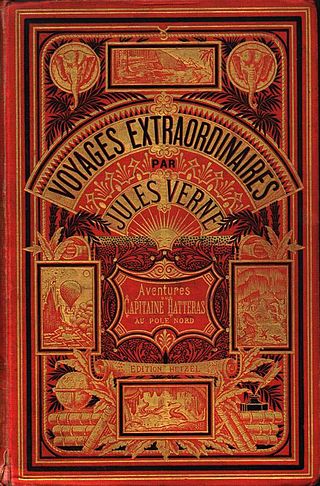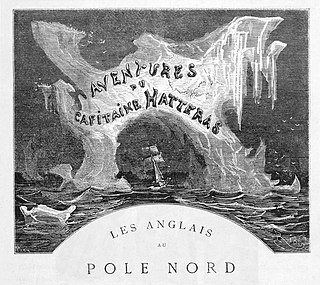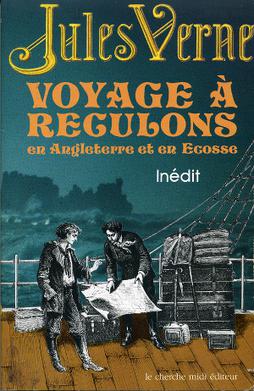
Jules Gabriel Verne was a French novelist, poet, and playwright. His collaboration with the publisher Pierre-Jules Hetzel led to the creation of the Voyages extraordinaires, a series of bestselling adventure novels including Journey to the Center of the Earth (1864), Twenty Thousand Leagues Under the Seas (1870), and Around the World in Eighty Days (1872). His novels, always well-researched according to the scientific knowledge then available, are generally set in the second half of the 19th century, taking into account the technological advances of the time.

Twenty Thousand Leagues Under the Seas is a science fiction adventure novel by the French writer Jules Verne. It is often considered a classic within both its genres and world literature. The novel was originally serialised from March 1869 to June 1870 in Pierre-Jules Hetzel's French fortnightly periodical, the Magasin d'éducation et de récréation. A deluxe octavo edition, published by Hetzel in November 1871, included 111 illustrations by Alphonse de Neuville and Édouard Riou.

From the Earth to the Moon: A Direct Route in 97 Hours, 20 Minutes is an 1865 novel by Jules Verne. It tells the story of the Baltimore Gun Club, a post-American Civil War society of weapons enthusiasts, and their attempts to build an enormous Columbiad space gun and launch three people – the Gun Club's president, his Philadelphian armor-making rival, and a French poet – in a projectile with the goal of a Moon landing. Five years later, Verne wrote a sequel called Around the Moon.

The Voyages extraordinaires is a collection or sequence of novels and short stories by the French writer Jules Verne.

The Carpathian Castle is a gothic novel by Jules Verne first published in 1892. It is possible that Bram Stoker took inspiration from this for his 1897 novel Dracula. Due to castle aspect and local toponymy, it is assumed that Colț Castle in Hunedoara county inspired Jules Verne. Probable inspiration for Verne was his extended stay in Bratislava and the Devín castle in present day Slovakia, where he also wrote his novel The Danube Pilot.

Texar's Revenge, or, North Against South is the full title of the English translation of the novel written by the French science-fiction author Jules Verne, and centers on the story of James Burbank, an antislavery northerner living near Jacksonville, Florida, and Texar, a pro-slavery southerner who holds a vendetta against Burbank. Originally published in France in 1887, the book received a tepid reaction upon its release in the United States, partly because of Verne's inexpertise regarding some details of the American Civil War, and has since fallen into obscurity compared to many of Verne's other works.

Dr. Ox's Experiment is a humorous science fiction novella by the French writer Jules Verne, published in 1872. It describes an experiment by one Dr. Ox, and is inspired by the real or alleged effects of oxygen on living things.

"A Drama in Mexico" is a historical short story by Jules Verne, first published in July 1851 under the title "L'Amérique du Nord, études historiques: Les Premiers Navires de la marine mexicaine."

The Adventures of Captain Hatteras is an 1864 adventure novel by Jules Verne in two parts: The English at the North Pole and The Desert of Ice.

The Fur Country or Seventy Degrees North Latitude is an adventure novel by Jules Verne in The Extraordinary Voyages series, first published in 1873. The novel was serialized in Magasin d’Éducation et de Récréation from 20 September 1872 to 15 December 1873. The two-volume first original French edition and the first illustrated large-format edition were published in 1873 by Pierre-Jules Hetzel. The first English translation by N. D’Anvers was also published in 1873.

The Survivors of the "Jonathan", is a novel that was written by Jules Verne in 1897 under the title Magellania. However, it was not published until 1909, after it had been rewritten by Verne's son Michel under the title Les naufragés du "Jonathan".

Édouard Riou was a French illustrator who illustrated six novels by Jules Verne, as well as several other well-known works.

The Chase of the Golden Meteor is a novel by Jules Verne. It was one of the last novels written by the prolific French hard science fiction pioneer. The book, however, is seen as less an early example of hard science fiction than a social satire lampooning greed, monomania and vanity. Verne first wrote La Chasse au météore in 1901 and then rewrote it before his death, but it was only published in 1908, three years after the author's death, one of seven such posthumous novels.

"A Drama in the Air" is an adventure short story by Jules Verne. The story was first published in August 1851 under the title "Science for families. A Voyage in a Balloon" in Musée des familles with five illustrations by Alexandre de Bar. In 1874, with six illustrations by Émile-Antoine Bayard, it was included in Doctor Ox, the only collection of Jules Verne's short stories published during Verne's lifetime. An English translation by Anne T. Wilbur, published in May 1852 in Sartain's Union Magazine of Literature, marked the first time a work by Jules Verne was translated into the English language.

The Secret of Wilhelm Storitz is a fantasy novel by Jules Verne, published by Louis-Jules Hetzel in 1910. The manuscript was written around 1897. It was the last one Verne sent to Hetzel.

The Golden Volcano is a novel by Jules Verne, edited by his son Michel Verne, and published posthumously in 1906.

Backwards to Britain is a semi-autobiographical novel by the French writer Jules Verne, written in the fall and winter of 1859–1860 and not published until 1989.

Journey Through the Impossible is an 1882 fantasy play written by Jules Verne, with the collaboration of Adolphe d'Ennery. A stage spectacular in the féerie tradition, the play follows the adventures of a young man who, with the help of a magic potion and a varied assortment of friends and advisers, makes impossible voyages to the center of the Earth, the bottom of the sea, and a distant planet. The play is deeply influenced by Verne's own Voyages Extraordinaires series and includes characters and themes from some of his most famous novels, including Twenty Thousand Leagues Under the Seas, Journey to the Center of the Earth, and From the Earth to the Moon.

Jules Verne (1828–1905) was a French novelist, poet, and playwright. Most famous for his novel sequence, the Voyages Extraordinaires, Verne also wrote assorted short stories, plays, miscellaneous novels, essays, and poetry. His works are notable for their profound influence on science fiction and on surrealism, their innovative use of modernist literary techniques such as self-reflexivity, and their complex combination of positivist and romantic ideologies.
A Priest in 1839 is an unfinished novel by Jules Verne. Written around 1845-1848, it was published in 1992, long after the author's death.



















